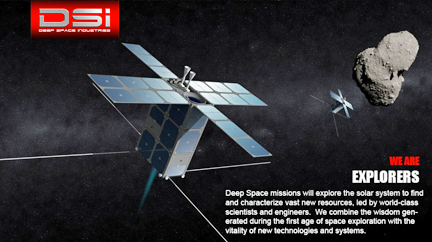
[SatNews] Deep Space last month opened a lab and office at the NASA Ames Research Park at Moffett Field in Silicon Valley, California, and expanded the professional staff.
The new facility provides space to begin assembly of the company’s initial spacecraft for a new project to be announced next month, with room to expand. The new location enhances the visibility of Deep Space with the NASA-Ames leadership for partnering and contracting. Ames is NASA’s lead center for small spacecraft and hosts a number of agency experts in commercial space. The new facility is in close proximity to technology-savvy investors, partners and a skilled technology workforce.
Deep Space also is growing its team with several new hires and research collaborators. Colorado-based Rhonda Stevenson is now Chief Sales and Promotions Officer, starting with the revamp of the Deep Space By Design retail web site and also covering games, apps, and retail product licensing.
Mark Sonter, the company’s Director of Mining and Processing, has been expanding his team with additional experts. Among them is Gavin Beer, a metallurgical consultant and chemical engineer, who is developing a process flow sheet for extraction of volatiles from carbonaceous chondrite asteroids. Asha Rao, an exploration and resource assessment geologist, and Sophia Casanova, an oil and gas geologist, are expanding on the company’s existing analysis of how to quantify the probability of exploration success in the face of uncertainties about specific asteroid targets.
Chief Scientist Dr. John Lewis is now complemented by Sebastian Ernst, a Germany-based researcher who has spearheaded several Deep Space proposals to NASA. Sebastian also is leading Deep Space’s development of a system for evaluating the deltaV and trip-lengths required to access near Earth asteroids, assisted by DSI Astrodynamics Lead Dr. Chris Cassell and Dan Parcher.
The Deep Space team is also one month into producing results for the two NASA contracts awarded to help the agency plan its Asteroid Redirect Mission (ARM). NASA expects interim reports from Deep Space in late October will provide guidance on whether ARM should grab a tiny (4 to 8 meter) free-floating asteroid or visit a larger target to gather material from the surface.
One of the NASA contracts calls for analysis of secondary spacecraft to carry out early scouting missions. NASA’s rules for selecting the final target require that the asteroid’s characteristics be confirmed ahead of time. For the option of collecting a tiny asteroid, this means the target must have passed close by Earth for radar examination of its true size and spin rate. For the option of gathering boulders from a large asteroid, the target must have been imaged at close range to show that boulders actually exist on the surface. Only three such targets for each option have been confirmed thus far. Deep Space low-cost scouting missions would expand the confirmed candidates to include carbonaceous chondrites with the volatiles needed to produce rocket propellant and materials for life support.
One interesting asteroid is 2000 SG344, the easiest target for a round-trip robotic harvesting mission or crewed visit in NASA’s NHATS table. SG344 is on the opposite side of the solar system from Earth at the moment, and won’t make a close pass until 2028. However, Deep Space analysts have identified several opportunities for a small prospecting spacecraft to inspect SG344 well in advance of the next conjunction to see if has the right stuff for harvesting. Collaborating with Deep Space on this research is Dr. Mason Peck of Cornell University, developer of tiny spacecraft called Sprites that mass less than five grams each. Dr. Peck is a former NASA Chief Technologist.
The other NASA contract seeks Deep Space advice on how the ARM could be modified to encourage private-sector funding of related activities, such as commercial utilization of the tonnes of returned material after the astronauts have left with their 50kg of samples. Deep Space is working with Hoyt Davidson of investment advisers Near Earth LLC on policies that would incentivize private-sector initiatives related to ARM.
For additional information, please visit the Deep Space infosite at http://www.deepspaceindustries.com/#

